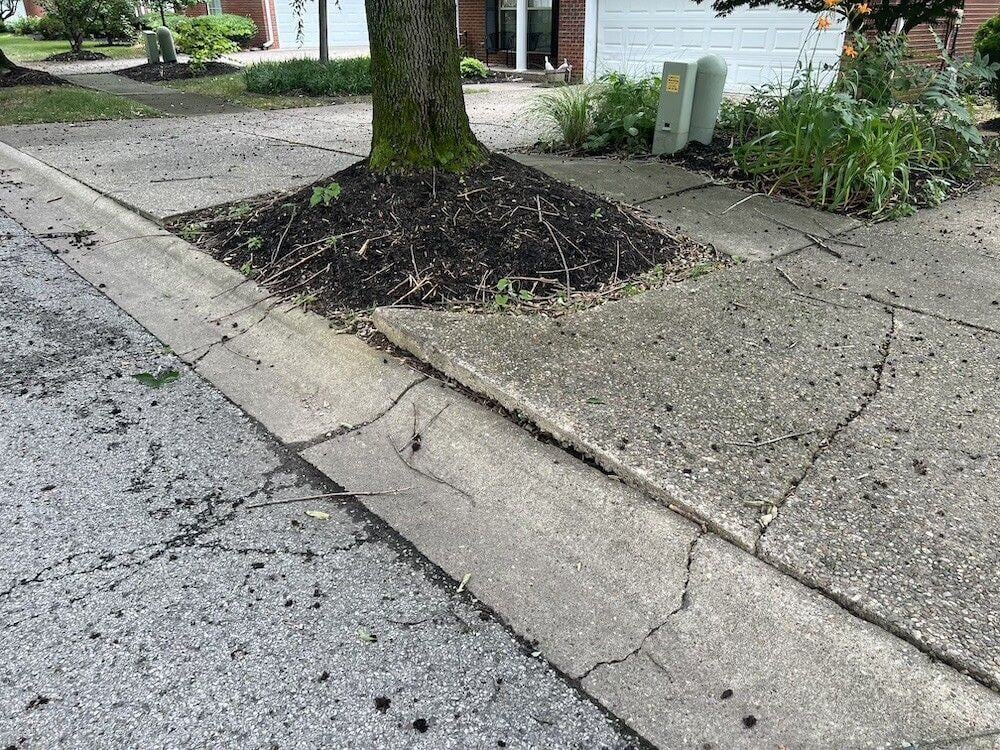What To Know Before Planting Trees Near Your Foundation or Concrete Slabs
July 12th, 2024 | 3 min. read
By Sarah Etler

Learn about the risks and potential benefits of planting trees near the concrete on your property.
Trees are a beautiful part of your house’s landscape and can make you feel calm, comfortable, and at home. They provide shade during the hot summer months, offer you a place to hang your bird feeder, and provide a natural feel, whether you’re downtown or in the suburbs.
However, trees can also be a threat to your foundation and concrete sidewalks, driveways, patios, and any other expensive concrete structure.
While you’re enjoying the autumn colors, your tree’s root may be hurting your foundation or concrete slabs. In this article, we’ll be sharing a few of the ways trees can affect your home’s foundation and concrete.
How Trees Can Hurt Your Home’s Foundation
Surprisingly, trees are not the direct cause of foundation damage. Unlike plumbing issues where tree roots can crack or fill pipes, tree roots are not strong enough to break your home’s foundation (although they can squeeze into a crack and force it to widen).
However, they do influence the soil conditions around your home. Here’s how:
Shifting Soils
Tree roots absorb water from the soil and create voids as they grow, causing the soil to shrink, settle, and move. This shifting can put stress on your foundation, leading to cracks and the need for foundation repair.
Over time, if the soil settlement is uneven, it can cause significant structural damage. Walls may sink or crack, chimneys might bow, and ceilings can become uneven. This type of severe damage typically affects older homes.
How Trees Can Hurt Your Concrete
When trees are planted too close to concrete surfaces such as sidewalks, driveways, and patios, their roots can grow and cause the concrete to become uneven.
As tree roots expand, they can push up against the concrete, creating trip hazards that can worsen as the roots continue to grow.
Beyond uneven, settled concrete, tree roots can lead to cracks and structural damage that require repairs or even full replacement of the affected concrete sections.
Pro Tip: This also applies to homes on slabs or shallow foundations. Instead of creating trip hazards, the roots can push up on the foundation and cause the home to lift unevenly over time.
How Trees Can Help Your Home’s Foundation and Concrete
Interestingly, trees can also have beneficial effects on your home’s foundation and concrete.
Trees help stabilize soil and improve drainage by soaking up excess moisture, particularly during wet seasons.
Trees also help prevent erosion, which is crucial if your home is on a slope. Trees can act as a natural barrier against soil erosion, protecting the integrity of your foundation.
The key is strategically planting trees and shrubs far enough away from the foundation to avoid potential damage while reaping the benefits of their beauty and function as described above.
How To Prevent Tree-Related Damage
To protect your foundation and concrete from tree root damage, consider these strategies:
-
Root Barriers
Install a root barrier between the tree and the foundation or concrete to block roots from spreading towards it.
Root barriers can be made of various materials, including plastic, metal, or fabric, designed to redirect roots away from vulnerable areas.
-
Choose Appropriate Trees
If planting new trees, select species with slower growth and less aggressive roots, such as oak or sugar maple. Avoid trees like silver maples and elms, which have extensive, strong root systems.
Remember, tree roots can extend two to three times the height of the tree, so plant accordingly. Consider consulting with a landscaping expert or arborist to choose the best tree species for your yard and the appropriate distance to place the tree from your home.
-
Regular Maintenance
Regularly inspect the trees near your foundation and concrete for signs of root encroachment.
Prune roots as needed to prevent them from growing too close to your home. Also, maintaining a consistent watering schedule can help prevent roots from seeking out moisture under your foundation or concrete slabs.
Should You Remove Trees Damaging Concrete or Foundation?
You don’t have to remove beautiful, healthy trees from your yard due to the potential for root damage.
Instead, get an analysis of your soil type and foundation status to determine how big of a threat roots are to your foundation and whether you will need future foundation repair.
Cutting down a tree should be the last resort. With the right precautions, you can enjoy the beauty and benefits of trees without compromising your home’s structural integrity.
Repair for Tree Roots Lifting Concrete Slabs
If your trees are lifting concrete slabs out of place, concrete leveling may be able to help even out the area.
Rather than removing the affected concrete and replacing it, or removing the tree and its roots, the concrete leveling process works by lifting the adjacent slabs to create an even grade with the lifted slab.
Read More: Tree Roots Lifting Concrete? Here’s What To Do
Want to know if your concrete lifted by tree roots can be fixed with concrete leveling? Request a free onsite estimate with an A-1 team near you, and be sure to attach photos of the area when you submit the form!
Sarah Etler joined A-1 Concrete Leveling after receiving her Bachelor of Arts degree in English from Northern Kentucky University. As A-1's Content Marketing Manager, she works closely with industry experts to produce content that will best answer questions related to concrete repair and maintenance practices. Sarah loves living a life full of discovery and is excited every day to see what new things she can learn and share with those around her.